#shinsengumi history
Explore tagged Tumblr posts
Text
"As he prepared for death, it is said that he arranged for the sword to be delivered to his family"
This pretty much confirms that Tetsunosuke delivered the Izuminokami Kanesada to Hijikata's family. Great video! The sword is so beautiful.
33 notes
·
View notes
Text
Guess who has done something extremely stupid? Me!
I used to use a website (only accessible through the wayback machine) that was a compilation of biographies of the members of the Shinsengumi (including early members like Serizawa) as ressources for my writing. I apparently did not register any link to access it!!! Which means that I can't find it back.
This website (fully in english) had a main page listing the members and you could click on their names to access their bio. There was no pictures only text. One page was dedicated to giving few sentences bio on several members that were not as famous as the one most often mentioned ones. It's on this website that I read that Hijikata's blind brother used to write poetry, or that Kondo was adopted because he was noticed after fighting back against a thief... Does that ring a bell for anyone? If yes, could you give me a link?
Maybe @talesofedo or @kumoriyami-xiuzhen or maybe @queengurako?
(sorry if this is a bother but I feel desperate and like a colossal idiot too)
#japanese history#shinsengumi#hijikata toshizo#okita souji#kondo isami#serizawa kamo#hakuouki#peacemaker kurogane#chiruhan#please i feel so stupid#this website was goldmine and I lost the way to it
49 notes
·
View notes
Text
(Friday Night History) Members' Episode 12: Shinsengumi, Part One
By patron request: Part One of a short history of the Shinsengumi, one of the most popular and in my opinion least understood units of the Bakumatsu era in Japan: https://www.patreon.com/posts/friday-night-1-115803469 As you will note, this post is the first post on Patreon that I have enabled for individual sale. Given the topic it covers, I thought that might be a good idea. This is an…
6 notes
·
View notes
Text
Wow have not checked Tumblr in 7 years. Shocking.
Mostly here because I majorly revived my obsession with Sannan Keisuke of Hakuoki fame (or infamy depending on who you ask). Since Hakuoki Kyoto Winds / Edo Blossoms came out on Steam, I have played Sannan's route exclusively because 1) it breaks my heart too much to see him villainized, and 2) it kinda makes me feel like I'm cheating on him to play other routes? Haha, I'm a dork.
I've also recently started rewatching the Shinsengumi! Taiga drama and can't help but lament how we can't use the Ochimizu to save all those tragic young men from their inevitable fates.
(Somewhat spoiler I guess? For both Hakuoki Sannan route and Shinsengumi! live action taiga drama)
Honestly, the fleeting yet impactful existence of the Shinsengumi is a fitting setting for an otome game where the love interests can become vampires instead of dying as they do in history.
One thing that rather interested me is that I found out there is a historical precedence for Sannan's arm injury that leads him to be the first member of the Shinsengumi to imbibe the Water of Life.
Sources:
https://shinsengumi.net/index.php/2020/09/28/yamanami-keisuke-sannan/
https://shinsengumi-archives.tumblr.com/post/188360328151/yamanami-keisuke-shinsengumi-no-makoto
Before reading about it, I assumed his more widely accepted fate in history (that he broke the Shinsengumi's laws by leaving due to his moral objection to their shifting ideologies and increasingly ruthless methods, got caught in the act, and was forced to commit seppuku by Hijikata) was the true one.

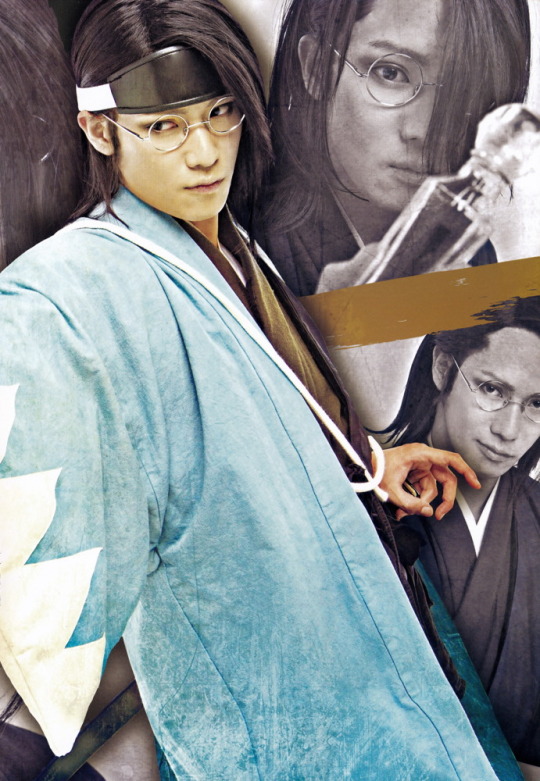
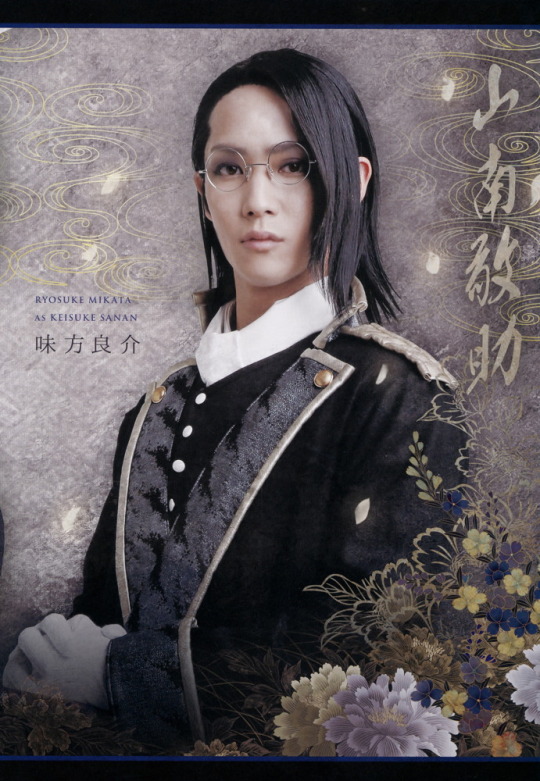
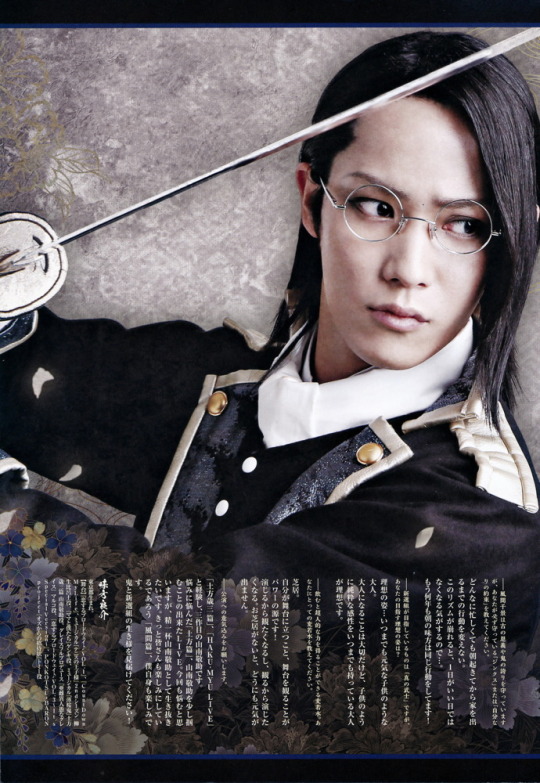
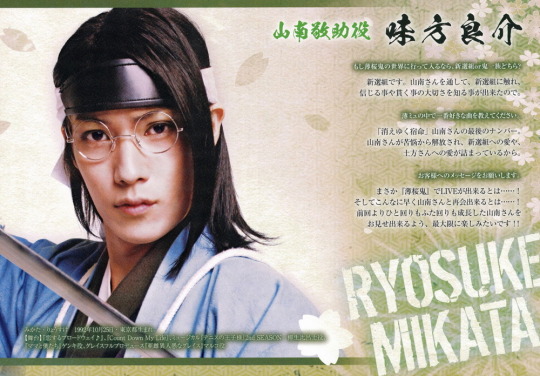

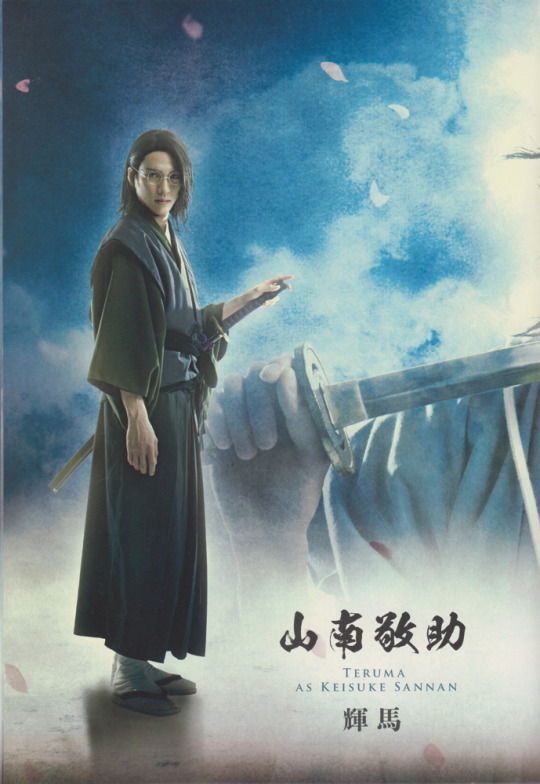

Guess who is on my phone's lock screen now? (Too bad HakuMyu doesn't do Sannan's route...)
#hakuoki#hakuoki kyoto winds#hakuoki edo blossoms#sannan keisuke#yamanami keisuke#shinsengumi#hakumyu#otome#japanese history#hi again tumblr#tagging is hard#spoilers#why no inline spoiler tags tumblr
17 notes
·
View notes
Text
I know this poll is almost a year old but after a talk with @talesofedo (you can contribute to the conversation if you want to!) and a worried follower who talked to me through DM who I suppose voices a lot of concern and uncomfort of many others who may be wondering what was going on with Hijikata and Tetsunosuke in real life, my answer regarding the topic is: no.
There's no historical evidence that Hijikata and Tetsunosuke had "that" kind of relationthip in real life, if they were, I think there would be records about that (I mean, we know about Oda Nobunaga's relationship with Ranmaru so if something happened between Hijikata and Tetsunosuke it would had been recorded), but there aren't. If anything, all points out that their relationship was purely platonic and that Hijikata at most came to care for Tetsunosuke and the rest of the other pages as a father figure. Testimonies of his descendants say he came to make sure all the pages (which most of them were young boys, Tetsunosuke himself was 16 and Tamura Ginnosuke was 14) weren't exposed to the battlefield because the risk they faced there, he clearly was concerned about them because their young ages so that pretty much puts him a quasi-fatherly role for them.
On the other hand, @talesofedo explained to me that wakashuudo changed a bit during the Bakumatsu period, in that relationships between men from the same age range became more common than the large age gaps that existed in the Sengoku and the early Edo period, they told me there are many records of teenagers among similar ages in romantic relationships, the same goes for older men, now, I'm not saying that the traditional wakashuudo age gap relationships didn't happened in the Bakumatsu, however, talesofedo told me that apparently they became less common than before.
And finally, many of the pages that entered the Shinsengumi were young boys who were there mostly there to serve as assistants instead of having the more traditional master/page relationships. Inoue Taisuke, age 12 and nephew of Inoue Genzaburou, was Kondou's page, and no way that boy and Kondou were doing "that", Taisuke left the Shinsengumi after the Battle of Toba-Fushimi with his uncle's...hair or head? so he could return it to his family and mourn him properly.
Again, there's a lot that we don't know because there are no records, the so called silences of History, so maybe we can be wrong or who knows? however, based on what we know of Hijikata and Tetsunosuke's relationship from the historical records that survived about them, including from the Hijikata family, it seems their relationship was platonic in every sense.
Ok the other one's looking a little too decisive so only vote on this one if you know what a wakashuu is/ understand the cultural reasons why a samurai and his page might get frisky
(Again, speaking strictly about the historical figures)
#anyway i have seen some people worried about this topic so i chose to talk about it to easy them a bit#if that helps#shinsengumi history#japanese history#hijikata toshizou#ichimura tetsunosuke#wakashuudo#tw ephebophilia talk#can't think of other tw that apply#tw teacher/student relationship#perhaps?#mod tsubaki
5 notes
·
View notes
Note
What are your favourite time periods besides Roman empire?
I'm actually a Late Republic kind of guy, idc much about the empire except for Caligula, but! to answer your question:
12th-14th century italy, imperial china (specifically the ming dynasty), colonial-revolutionary philippines, fucking. colonial america (or amrev, as some people refer to it. this one I hate admitting because I'm so fucking disinterested in the romanticized version of it that a lot of people enjoy, but I've been obsessed since I was 7 and when I was living in new england I spent all my free time going to reenactment events and museums)
#the joseon dynasty and medieval history interests me a lot too#old and middle kingdom egypt. what else. 14th-16th century japan??#also 1800s japan but specifically the shinsengumi#ask tag
29 notes
·
View notes
Text

#neko neko nihonshi#meow meow japanese history#historical shinsengumi#shinsengumi#okita souji#kondo isami#hijikata toshizo#i watched a couple of episodes from season 3 (9 and 10)#what if violent history but with cats and for kids#okita's illness was a lot of hairballs.#hijikata collection
3 notes
·
View notes
Text
5 Trivia about The Last Samurai
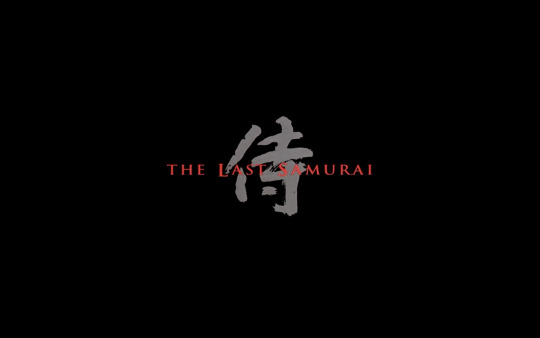
Although The Last Samurai is known to be historically inaccurate, I realized that some part of it does make sense but the producers just tried to simplify it for the audience as not everyone knows the complex history of Japan.
1. Katsumoto and Hasegawa

They fought together for the Emperor but now they fight on opposing sides.

Katsumoto 's character is based on Saigo Takamori of Satsuma .

Hasegawa is probably inspired by Hasegawa Yoshimichi of Choshu .
Historically, Satsuma once supported the Shogunate (Shogun) while Choshu supported the Imperial (Emperor). But over time Satsuma realized the urgency of change and embrace new technology in the face of emerging Western Powers and that the decaying and stubborn Shogunate will destroy the country .
Satsuma join forces with Choshu to overthrow the Shogunate. After they succeeded, Satsuma realized they got played as the new Imperial government is dominated by Choshu instead of having lords from various clans to govern the country and retaining the Samurai way of life but with modern technology .
This sparks the Satsuma Rebellion against the Imperial (Emperor) where former Samurai rallied to Saigo Takamori. While the Imperial is fully modernized and equipped with guns and canons, Satsuma has limited supplies by then and the Ronin that rallied to the cause are poor and uses Katana and arrows.
2. Guns and Samurai

So yes, guns are available since the time of Oda Nobunaga who changed the way of war in Japan and the number of guns used in battle increases as time goes by so one would think that by the time The Last Samurai takes place everyone should have guns right?
While the movie showed Katsumoto as a man of principles to not use modern weapons but there is a practical reason : money. After the collapse of the Shogunate, the Imperial strip the Samurai of their lands, earnings and status, so they became poor and could not afford to buy more guns.
Guns are not cheap, especially when there is high demand for the European traders to make profit. A reason why in the early days, some Kyushu lords convert to Christianity. Not out of faith but to get exclusive deals of cheap new guns in exchange of allowing the priests into their domains to preach.
3. Poor Samurai
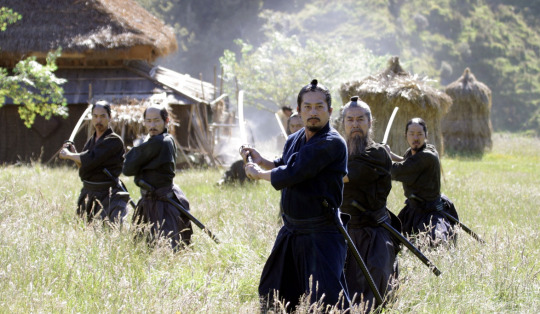
Where is Katsumoto's castle? Every Daimyo has his own castle. As mentioned, since the Samurai are stripped of their lands, the Castles are now under the control of the Imperial. So Katsumoto withdrew to the mountains of his ancestral place at his son’s village, where the monks and peasants are.
Here he reflected his past actions, probably regretting what he had done and seen at Aizu. While the Satsuma are reasonable but the Choshu are less forgiving due to their personal grudges with the Tokugawa Shogunate that strip away their lands and dignity after their defeat at Sekigahara .
In the Japanese Drama, Yae No Sakura , when the Imperials entered Aizu, the Satsuma was shocked to find most of the defenders are women and children who committed seppuku to avoid capture, lying dead all over Aizu, which disturbed the commander who was expecting Samurai and foot soldiers.
I like to think this commander is Katsumoto which is why he understands what Algren was feeling knowing that they both do not deserve to live.
4.The European Samurai
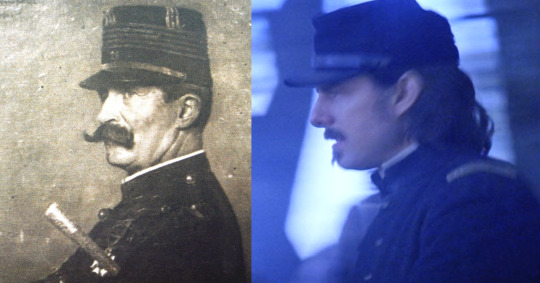
Nathan Algren is based on Jules Brunet of the French military who was sent to Japan by Napoleon III to train the Japanese in modern weaponry. He was caught in the crossfire when the Boshin War broke out and received orders to return home to France but he rejected it to stay and fight with the Samurai.
He trained the Aizu Samurai and develop comradeship with them, particularly with the Vice Commander of the Shinsengumi , Hijikata Toshizo . Although Jules Brunet did not wear Samurai armor but he did fought alongside them till the end until the death of Hiijikata at Hokkaido when they were outnumbered.
But Jules Brunet managed to return safely to France just as Nathan Algren survived the war. And just as Nathan Algren talked to the Emperor about how Katsumoto lived his life as a Samurai, Jules Brunet wrote in his memoir, holding Hiijikata Toshizo in high regard , referring to him as the last true Samurai.
5. English Speaking Samurai
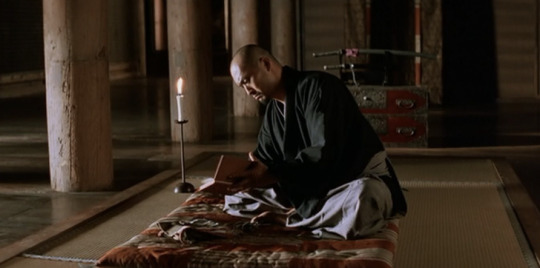
Since the arrival of the Europeans and Black Ships, the Samurai have been studying in earnest about Western medicine and technology, hoping to elevate their standing on the world platform and be an equal to the European powers as they fear of what happened to China in Opium Wars happen to them next. Not all, but the high ranking Samurai, especially those on the West of Japan like the Satsuma and Choshu who have been trading with Europeans for many years and have begun learning their languages so it is of no surprise that Katsumoto knows English which he teaches his son as well.
Besides, unlike the early days of the Samurai, during the 300 years of peace and isolation under Tokugawa Shogunate, the Samurai learn to read and write in order to help the Shogun administer and govern the country including land surveying, tax collecting and accounting balance sheets .
Thoughts

Overall I think the producers did an amazing job simplifying the long and complex history of Boshin War and Meiji Restoration in a span of two hours plus movie without exaggerating. For a historical fiction I think it's pretty great. After all it'a not a documentary but a masterpiece meant to be enjoyed, filled with spirituality and life lessons.
But that is a story for another time. Thank you for reading.
youtube
#the last samurai#ken watanabe#tom cruise#boshin war#meiji restoration#satsuma rebellion#japan#japanese history#samurai#saigo takamori#jules brunet#hiijikata toshizo#shinsengumi#yae no sakura#oda nobunaga#sekigahara#opium war
52 notes
·
View notes
Text
LMAO xDDD @gladyscontrerasart
Regarding Hijikata's fertility, is stated that he did had a daughter with a geiko (I believe it was a geiko?) named Kimigiku/Okiku, however, the child died shortly after the birth. To be honest, I wouldn't be surprised if he fathered more children that we aren't aware about. The man was very popular with the ladies after all!

Very important conversations are happening.
52 notes
·
View notes
Text
absolutely compelled to do a Fact vs Fiction for ishin....
#spoilers#ishin spoilers#snap chats#there's some inaccuracies between history and the games- OBVIOUSLY#but i always like to compare and contrast#first instance i can think of is yamanami's death#but i guess that one's more up in the air than anything since it's still a bit of a mystery exactly on what happened#it's at least agreed upon that he was ordered to commit seppuku after okita retrieved him once he escaped to otsu#though details like why he was upset with the shinsengumi and even the nature of his relationship with hijikata arent perfectly accepted#at the very least for the latter hijikata supposedly dedicated one of his many poems to him so at the very least there's a level of respect#and that's not hard to believe- yamanami was a well-liked figure and his reasons for deserting aren't even that heinous#but im rambling now point is i think it'd be fun to compare and contrast :)
22 notes
·
View notes
Text

the gintama screenshot that haunts my dreams
#WHYS IT 2011#chitra.txt#gintama#i mean . its just a 4th wall break and if u read it as gintama being set in 2011 like#thats acceptable tbh. alternate history#but the shinsengumi are there ............................
5 notes
·
View notes
Text

#shinsengumi#bakumatsu#kondo isami#isami kondo#hijikata toshizo#geisha#japanese history#japan#meme#funny memes#samurai
1 note
·
View note
Text
You can find more info about Hijikata in this defunct side, shinsengumi-no-makoto (although it seems it also has some old information that has been debunked, but it's pretty informative) and Hijikata's page in the Japanese Corps Wiki. It's very interesting! @shinsengumi-archives also has translated some quotes by him.
also more fun facts about hijikata bc i have a severe case of brain worms
he liked reading poetry and even wrote many himself although it's debatable whether they were very good. you can read a collection of them here
he never actually mastered the tennen rishin style but he did use what he learned to develop the shinsengumi kenjutsu fighting style
he was known as 鬼の副長 (oni no fukucho aka demon vice commander) because of his ruthlessness in enforcing the kyokuchuu hatto which was the so called iron code of the shinsengumi
he was known as somewhat of a pretty boy and was popular among women but he was very narcissistic and would collect love letters from geisha to send to his home town
12 notes
·
View notes
Text

Bloody Shikyo
This one took a while. Depicting a gloomy night in a Shikyo (the fantasy edo equvilent) gated suburb that has become the unlucky target of a raid by the Kogeki Keisatsu, suspected of harboring rebellion.
The 攻撃警察 on his uniform means Strike Police, this universe's S.W.A.T mixed with Doshin. He wields a Tateto, or Shield Blade (basically a sabre) alongside a spearheaded lantern-holder.
His uniform is reminicent of a mix of Edo-Period Doshin, Late Armored Samurai, and Shinsengumi.
#japan#culture#asia#history#samurai#shinto#war#japanese#art#creativity#edo period#shinsengumi#blood#horror#battle#military#police#digital art#original character#original art#alternate universe#my own art#my art#au#AU
2 notes
·
View notes
Text
Alright, it's time. This is referring to the actual historical people. There's no "I don't know" option for a reason. Go with what your gut is telling you in this moment.
Please share your reasoning in the comments there are so many compelling arguments either way
#Bakumatsu#Shinsengumi#hijikata toshizo#ichimura tetsunosuke#peacemaker kurogane#hakuouki#kaze hikaru#japanese history
4 notes
·
View notes
Text
Friday Night History Members' Episode 13: "Shinsengumi: Part Two"
Aizu and Satsuma barricade the palace grounds! And one little unpredictable unit of mercenaries attains distinction that earns a new name. “Shinsengumi,” Part Two, is up for patrons and individual purchase: https://www.patreon.com/posts/116704913
2 notes
·
View notes